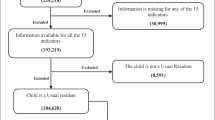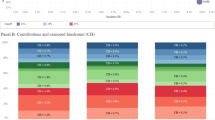Abstract
Despite increased recognition of the importance of measuring child poverty from a multidimensional perspective, most countries with National Multidimensional Poverty Indices (MPIs) have used the household as the unit of identification and used the results of national MPIs to define the levels of child poverty in a country. This assumes that resources are shared equally among all household members, and ignores possible intra-household inequalities. Given the lack of knowledge about whether Household MPIs properly identify children who are multidimensionally poor, this article aims to compare the results of a child-specific MPI exercise and a household-specific MPI exercise and identify the dimensions and individual characteristics that explain this gap. To fulfil this objective, we computed a Child MPI for Colombia and compared the results with the Colombian National MPI. In addition, we estimated probit and biprobit models to identify the determinants of being a multidimensionally poor child under both measures. The results of the analysis reveal three main findings: (1) there is a mismatch between the two measures; (2) the deprivation profiles of multidimensionally poor children are different depending on which MPI is used to classify them as poor; and (3) children who are multidimensionally poor according to a Child MPI have different individual and family characteristics compared with children who are classified as poor according to a Household MPI. These three main findings reveal that it is necessary to analyse child poverty using an MPI that captures individual deprivations.


Similar content being viewed by others
Notes
In Colombia only García and Ritterbusch (2015) have calculated a Child MPI using the child as unit of identification. This Child MPI included nine dimensions and 17 indicators and was calculated using the Quality of Life survey 2014. Given data limitations, it was not possible to compute this Child MPI.
The results of the analysis were also computed using a k equal to 21%; thus, a child was considered multidimensionally poor if she was deprived in 21% or more of the weighted sum of deprivation or in more than one dimension. The results of this last analysis are available upon request.
Under the Child MPI, children younger than age 5 were identified as poor mainly because of the inclusion of the indicator on learning environments. This explains why the proportion of children under 5 is so high in Group 2. In the case of the Household MPI, children aged 15 to 17 years have higher levels of deprivation and multidimensional poverty, mainly given because the high contribution of education achievement and school lag, which explains the higher proportion of this age group in Group 3.
References
Alkire, S., & Roche, J. M. (2011). Beyond headcount: Measures that reflect the breadth and components of child poverty. OPHI Working Paper N., 45.
Alkire, S., Foster, J., Seth, S., Santos, M. E., Roche, J. M., & Ballon, P. (2015). Multidimensional poverty measurement and analysis. Oxford: Oxford University Press.
Alkire, S., Lham, D., Gyeltshen, S., & Minten, T. (2016). Child poverty in Bhutan: Insights from multidimensional child poverty index and qualitative interviews with poor children. Bhutan: Thumphu.
Alkire, S., Conconi, A., Pinilla-Roncancio, M. & Vaz, A. (forthcoming) How to Build a National Multidimensional Poverty Index (MPI): Using the MPI to inform the SDGs. Oxford: University of Oxford, United Nations Development Programme (UNDP).
Angulo, R., Díaz, Y., & Pardo, R. (2015). The Colombian multidimensional poverty index: Measuring poverty in a public policy context. Social Indicators Research, 1–38.
Bader, C., Bieri, S., Wiesmann, U., & Heinimann, A. (2016). Differences between monetary and multidimensional poverty in the Lao PDR: Implications for targeting of poverty reduction policies and interventions. Poverty & Public Policy, 8(2), 171–197.
Ballon, P., Cockburn, J., Dessy, S. & Diarra, S. (2016) Monetary and multidimensional child poverty: Why they differ. PEP working paper serie 2016–29.
Biggeri, M., Trani, J.-F. & Mauro, V. (2010 ) The multidimensionality of child poverty: An empirical investigation on children in Afghanistan.Florence.
Brown, C., Ravallion, M., & Walle, D. (2017). Are poor individuals mainly found in poor household? Evidence using nutrition data for Africa. Working paper 24047. Cambridge: National Bureau of Economic Research.
Departamento Administrativo Nacional de Estadistica (DANE) (2017) Metodología General Encuesta Nacional de Calidad de VIda -ECV 2016. Bogotá.
Departamento Administrativo Nacional de Estadistica (DANE) (2018) Comunicado de prensa, estadísticas de pobreza multidimensional 2017. Bogotá.
García, S., & Ritterbusch, A. (2015). Child poverty in Colombia: Construction of a multidimensional measure using a mixed-method approach. Child Indicators Research, 8(4), 801–823.
Gordon, D., Nandy, S., Pantazis, C., Pemberton, S., & Townsend, P. (2003). Child poverty in the developing world. Bristol The policy press.
Greene, W. (2003). Econometric analysis, 5th Edition. New York: Prentice-Hall Press.
Haddad, L., & Kanbur, R. (1990). How serious is the neglect of intra-household inequality? The Economic Journal, 100(402), 866–881.
Inter-Agency and Expert Group on Sustainable Development Goal Indicators (2016) Final list of proposed Sustainable Development Goal indicators 2016. Available online: https://sustainabledevelopment.un.org/content/documents/11803Official-List-of-Proposed-SDG-Indicators.pdf. [Accessed 5 Feb 2019.
Klasen, S., & Lahoti, R. (2016). How serious is the neglect of intra-household inequality in multidimensional poverty indices. Mimeo.
Leu, C.-H., Chen, K.-M., & Chen, H.-H. (2016). A multidimensional approach to child poverty in Taiwan. Children and Youth Services Review, 66, 35–44.
Long, J. S., & Freese, J. (2001). Regression models for categorical dependent variables using Stata. Collage Station: Stata press.
Main, G., & Pople, L. (2011). Missing out: A child centred analysis of material deprivation and subjective well-being. London: The Children's Society.
Ministerio de Desarrollo Social. (2015). Nueva Metodología de Medición de la Pobreza por Ingresos y Multidimensional. Santiago de Chile: Ministerio de Desarrollo Social.
Minujin, A., Delamonica, E., Davidziuk, A., & Gonzalez, E. D. (2006). The definition of child poverty: A discussion of concepts and measurements. Environment and Urbanization, 18(2), 481–500.
Noble, M., Wright, G., & Cluver, L. (2006). Developing a child-focused and multidimensional model of child poverty for South Africa. Journal of Children and Poverty, 12(1), 39–53.
Notten, G., & Roelen, K. (2012). A new tool for monitoring (child) poverty: Measures of cumulative deprivation. Child Indicators Research, 5(2), 335–355.
Pinilla-Roncancio, M., & Silva, R. (2017). Children in Angola: Poverty, deprivation and child labour. Child Indicators Research, 1–25.
Pinilla-Roncancio, M., Gonzalez-Uribe, C., García, S., Ritterbusch, A., Carrero, A. L. & Sanchez Franco, S. (forthcoming) Decisiones metodológicas en el diseño de un IPM infantil para Latinoamérica.
Qi, D. & Wu, Y. (2018) Comparing the extent and levels of child poverty by the income and multidimensional deprivation approach in China. Child Indicators Research.
Ritterbusch, A. E., Sánchez-Franco, S., Pinilla-Roncancio, M., Jaramillo, S. G. & González-Uribe, C. (forthcoming-a) Exploring the Possibility of Participatory Poverty Measurement: Who are the Experts in Research on Child Poverty?
Ritterbusch, A. E., Sánchez-Franco, S., Pinilla-Roncancio, M., Jaramillo, S. G., González-Uribe, C. & Carrero, A. L. (forthcoming-b) Conceptual Debates on Poverty Measurement: The Use of Qualitative Expert Consultation in Mixed-Method Multidimensional Poverty Research.
Rodríguez, L. (2016). Intrahousehold inequalities in child rights and well-being. A barrier to Progress? World Development, 83, 111–134.
Roelen, K. (2014). Multidimensional child poverty in Vietnam from a longitudinal perspective—Improved lives or impoverished conditions? Child Indicators Research, 7(3), 487–516.
Roelen, K. (2017). Monetary and multidimensional child poverty: A contradiction in terms? Development and Change, 48(3), 502–533.
Roelen, K. (2018). Poor children in rich households and vice versa: A blurred picture or hidden realities? The European Journal of Development Research, 30(2), 320–341.
Roelen, K., & Camfield, L. (2013). A mixed-method taxonomy of child poverty – The case of Ethiopia. Applied Research in Quality of Life, 8(3), 319–337.
Roelen, K. & Gassmann, F. (2008) Measuring child poverty and well-being: A literature review. Munich Personal RePEc Archive, MGSoG/2008/WP001.
Roelen, K., Gassmann, F., & de Neubourg, C. (2009). The importance of choice and definition for the measurement of child poverty—The case of Vietnam. Child Indicators Research, 2(3), 245–263.
Roelen, K., Gassmann, F., & de Neubourg, C. (2010). Child poverty in Vietnam: Providing insights using a country-specific and multidimensional model. Social Indicators Research, 98(1), 129–145.
Roelen, K., Gassmann, F., & de Neubourg, C. (2012). False positives or hidden dimensions: What can monetary and multidimensional measurement tell us about child poverty in Vietnam? International Journal of Social Welfare, 21(4), 393–407.
Trani, J.-F., Kuhlberg, J., Cannings, T., & Chakkal, D. (2016). Multidimensional poverty in Afghanistan: Who are the poorest of the poor? Oxford Development Studies, 44(2), 220–245.
United Nations children’s Fund (UNICEF) (2016) Ending Extreme Poverty: a Focus on Children.
United Nations Children's Fund (UNICEF). (2005). The state of the World’s children 2005: Childhood under threat. New York: UNICEF.
United Nations Human Rights Office of the High Commissioner (1989) Convention on the rights of the child. Geneva OHCHR.
Vijaya, R. M., Lahoti, R. & Swaminathan, H. (2014) Moving from the household to the individual: Multidimensional poverty analysis. World Development, 59(0), 70–81.
Wooldridge, J. M. (2009). Introductory Econometrics. A modern approach, fourth Edition edition. Manson: South-Western Cengage Learning.
Zavaleta, D. (2017). What are the dimensions and indicators most commonly used by countries in their nationals MPIs? Dimensions Magazine, (2), 13–17.
Author information
Authors and Affiliations
Corresponding author
Additional information
Publisher’s Note
Springer Nature remains neutral with regard to jurisdictional claims in published maps and institutional affiliations.
Electronic supplementary material
ESM 1
(DOCX 29 kb)
Rights and permissions
About this article
Cite this article
Pinilla-Roncancio, M., García-Jaramillo, S., Carrero, A.L. et al. Child vs. Household MPIs in Colombia: Do they Identify the Same Children as Multidimensionally Poor?. Child Ind Res 13, 777–799 (2020). https://doi.org/10.1007/s12187-019-09639-1
Accepted:
Published:
Issue Date:
DOI: https://doi.org/10.1007/s12187-019-09639-1




